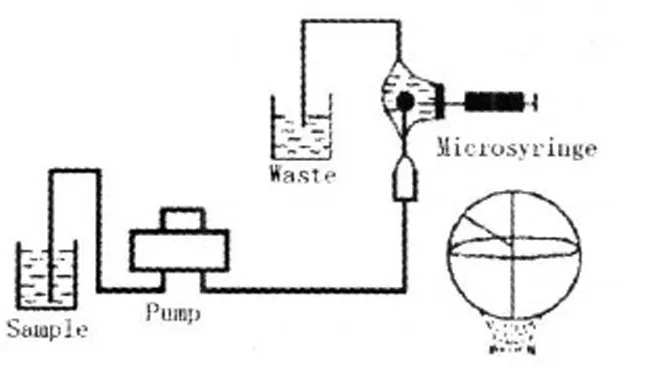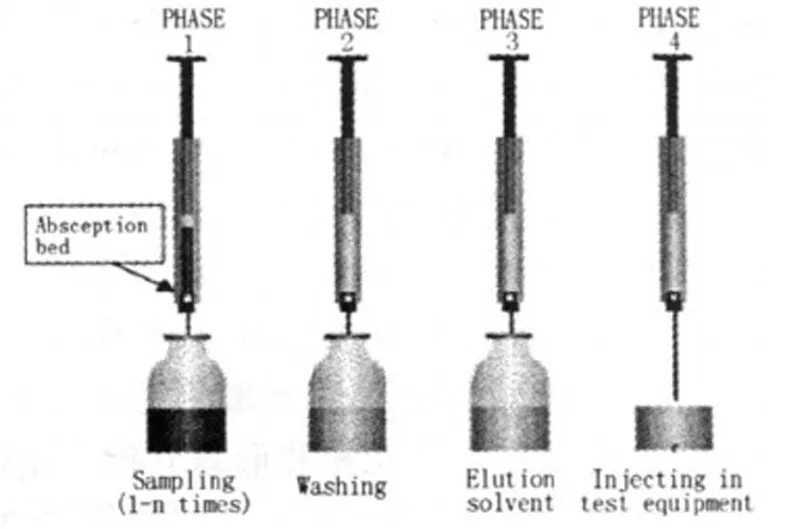ETV-ICP-OES/MS中的分离预富集技术
吴少尉,胡 航
(湖北民族学院 化学与环境工程学院,湖北 恩施 445000)
电热蒸发电感耦合等离子体原子发射光谱/质谱(ETV-ICP-OES/MS)分析技术中,电热蒸发(ETV)作为固/液体共同适用的微量进样装置,可以与各种传统的和新型的微型化分离预富集技术联用.使ETV-ICP-OES/MS联用检测技术在痕量/超痕量元素分析及元素形态分析中发挥重要作用.削弱甚至克服了以下困难:样品中目标元素的浓度极低,其各种不同形态的浓度则更低难检测;进样效率低,分析的灵敏度及准确性不高;大量共存基体成分所产生的干扰导致不准确的分析结果.建立一些分离基体、富集目标元素、简便快捷且环境友好的微型化样品前处理技术,是当前ETV-ICP-OES/MS应用研究中的重点和热点之一.本文在ICP-OES/MS中的进样技术[1]之后,从传统的和新型的分离预富集技术延续评论ETV-ICP-OES/MS中的分离预富集技术,以期就ETV-ICP-OES/MS研究给读者以及时捕捉前沿研究信息的目的.
1 传统的分离预富集技术
1.1 液-液萃取(Liquid-liquid extraction,LLE)
常规LLE的缺点是需要消耗大量的有机溶剂,环境欠友好,操作过程中有时产生乳化现象,费力费时.可是LLE技术成本低,无需特殊装置,操作简便,重现性好,样品容量大,目前在一些样品[2,3]分析中仍然还有应用.协同萃取(synergic extraction)是使用两种或两种以上萃取剂的混合物做萃取相的一种特殊的LLE技术,加入的第二种萃取剂(协萃剂)对萃取有增强作用,提高了萃取效率,被萃取物可得到更高的富集倍数.协同效应的性质和程度主要取决于协萃剂本身的性质,以及金属离子和螯合剂的性质.混配络合物的形成被认为是产生协同萃取效应、提高萃取效率的主要原因.如果一个中性给予体分子(协萃剂)从萃取螯合物中置换了水分子,则会降低该络合物的亲水性而有利于萃取.Matsubayashi等[4]采用噻吩甲酰三氟丙酮(TTA)和安息香酸(HB)实现了对稀土元素(REEs) 的协同萃取,发现随着原子序数的增大,由同样数目的水分子和稀土离子带来的熵变逐步占主导地位,从而影响络合反应,使络合物的二次稳定常数减小,导致协同萃取效应的逐步减弱.这个发现从理论上解释了协同萃取REEs时的变化规律,为更好的利用协同萃取来分析REEs奠定了基础.Yin[5]和Xiong[6]等利用协同萃取建立了ETV-ICP-MS测定环境样品中稀土元素的新方法.在相比不超过10时,均可得到5~7倍的富集.
1.2 固相萃取(Solid phase extraction,SPE)
SPE是通过一定粒径的多孔固体材料选择性地吸附溶液中的被测物质,即目标分析物被定量吸附后,再用体积较小的一种溶剂洗脱或用物理热解吸法解吸被萃取物,在此过程中达到分离基体、富集待测物质的目的,最后选用适当的检测方法进行分析测定.若难以洗脱而吸附材料廉价易得,也可以不经洗脱[1,7]直接将萃取待测物的固定相引入ETV中,设定合理的升温程序用ETV-ICP-OES/MS进行检测.与传统的LLE相比,固相萃取具有以下优点:①较理想的回收率(70%~100%),富集倍数高;②无相分离操作,处理试样体积弹性大,易于收集目标组分;③可现场采集,并分离/富集待测组分;④将试样脱盐,便于试样的储存和运输;⑤可供选择的固相萃取材料种类繁多,应用范围广;⑥避免使用有机溶剂,环境友好,操作简单,快速、易于实现自动化.SPE与ETV-ICP-OES/MS检测仪器的联用分析[8,9]已有很多报道,Valerie[10]对SPE原理、操作和应用等方面作了较为全面的评述.目前,对于SPE的研究主要集中在新型固相萃取材料的开发和萃取装置的微型化两方面.SPE柱材料的选择一般由分析目的和分析对象所决定,针对性的选择合适的萃取材料是成功建立一个分析方法的关键所在.目前,一些新型的功能吸附材料,如无机纳米金属氧化物[11]、碳纳米管[12]、介孔材料[13]、离子印迹材料[14,15]等,被不断开发出来并成功用于SPE及痕量元素分析.

表1 电热蒸发等离子体原子光/质谱中的样品前处理技术
2 微型化的样品前处理技术
作为一种微量进样技术,ETV与微型化的样品前处理技术联用是一种完美的微微结合,可使ETV-ICP-OES/MS 发挥出巨大的分析潜能,分析应用范围得到更进一步的拓宽.这与目前样品前处理技术微型化、绿色化的发展趋势相吻合.表1列出了ETV-ICP-OES/MS与各种分离富集技术联用的分析应用情况.下面将对一些微型化的样品前处理技术进行逐一介绍.
2.1 液相微萃取(Liquid-phase microextraction,LPME)
针对LLE技术的缺点,1996年Jeannot和Cantwell[30]发展和建立了一种绿色环保的新型样品前处理技术—LPME.与传统LLE技术相比,它只需要几十微升甚至几微升的有机溶剂,富集倍数高,特别适用于环境样品中痕量、超痕量污染物的测定.同时,该技术集萃取、浓缩和进样于一体,灵敏度高,易于实现与高灵敏的检测技术联用.迄今为止,已经发展了3种液相微萃取的萃取方式:直接单滴液相微萃取(direct single drop microextraction,Direct-SDME)、顶空单滴液相微萃取(headspace single drop microextraction,HS-SDME)和中空纤维膜液相微萃取(hollow fiber liquid phase Microextraction,HF-LPME).

图1 循环单滴微萃取示意图

图2 中空纤维液相微萃取示意图
Direct-SDME方式是利用悬挂在微量进样器针尖或聚四氟乙烯棒端的有机溶剂液滴浸没在样品溶液中对分析物进行直接萃取.Liu和Lee[31]报道了一种名为循环流微萃取的方法,对5种硝基苯化合物和6种氯苯化合物进行了分析,实现了260~1 600倍的高倍富集.吴英亮等[32]对该文献提出的装置进行了改进,将同一个装置用于连续流和循环流两种模式的萃取(如图1所示),首次将这种微萃取技术应用于无机物的分离富集中,建立了微滴溶剂萃取-低温ETV-ICP-OES检测超痕量La的新方法.Xia等将挥发性小、环境友好的离子液体用作萃取单滴[33],用ETV-ICP-MS测定了生物和环境样品中痕量有毒元素Pb、Hg、Cd.
将有机萃取液滴悬于样品溶液上部空间而进行萃取的方法,被称为HS-SDME[34],这种萃取方式对挥发性的目标分析物有较好的萃取作用.Zhang等[35]则直接使用比有机溶剂挥发性小的水作为溶剂,对试样中的挥发性离子型化合物进行了很好地分离富集.
基于中空纤维膜[36]的液相微萃取技术的建立,很好地避免了HS-SDME方式中液滴稳定性不好的问题,如图2所示.目标分析物通过不流动的、充满于中空纤维膜多孔结构中的薄层有机溶剂,从水相样品中被萃取出来,然后进入中空纤维膜内腔的接受溶液中,最后则可直接注入GC、HPLC、CE或ETV-ICP-OES/MS分析仪器中进行检测.
2.2 浊点萃取和分散相液相微萃取(Cloud point extraction,CPE and dispersive liquid-liquid microextraction,DLLME)
CPE是以中性表面活性剂胶束水溶液的溶解性和浊点现象为基础[37,38],通过改变体系温度引发相分离,将疏水性物质与亲水性物质分离.该技术不使用挥发性有机溶剂,是一种环境友好的液相微萃取技术.如表1所示,CPE技术与ETV-ICP-OES/MS联用在痕量元素测定及元素形态分析中已经得到了广泛的应用,主要集中在痕量金属离子的分离/预富集和痕量元素的形态分析[39]以及作为CE与HPLC分离之前的一种预浓缩手段[40,41].其操作方式也由传统的离线操作朝向在线操作[42]发展.
DLLME[43]是2006年出现的一种液相微萃取模式.这种微萃取的样品前处理方法起源于HLLE和CPE,是基于3种溶剂成分共存的体系,通过离心作用诱导相分离,使分析物进入第三相,然后将小体积的萃取相引入检测仪器中进行分析.在DLLME中,通过注射器将萃取溶剂和分散溶剂的混合物快速的注入到样品溶液中,水相溶液即刻变得浑浊,离心之后溶液分为两相,一相为澄清的水相溶液,另一相为微滴状的有机相.与其它模式的液相微萃取相比,DLLME操作简便,重现性好,更重要的是DLLME适合批量操作,萃取动力学快,在几秒钟之内即可完成平衡萃取,节省了分析时间.DLLME技术大多用于对有机物的分离富集方面,而其在无机物分析中的应用相对较少[44,45].
2.3 固相微萃取(Solid phase microextraction,SPME)
20世纪90年代,Pawliszyn等[46]研发出了一种集样品预处理和进样于一体的SPME技术.SPME是一种基于气固吸附和液固吸附平衡原理的分离富集方法,利用物质对活性固体表面(熔融石英纤维表面的涂层)的吸附亲合力不同而达到分离预富集的目的.它既有固相萃取操作简便、成本低、避免使用有机溶剂的优点,又克服了吸附剂孔道易堵塞的缺点.此外,SPME装置携带方便,特别适合于现场分析,也易于实现自动化.SPME自1993年由Supelco公司商品化以来,已有不同类型的商品化萃取头可供选择,并被广泛的应用于环境、生物技术、食品、医药等众多分析领域.
SPME方法是通过萃取头上的固相吸附剂涂层对样品中的待测物进行萃取和预富集,分为直接法、顶空法和膜保护3种操作方式:直接SPME法是将SPME纤维头直接插入水相或暴露于气体样品中进行萃取的方法.在样品充分搅拌的前提下,平衡所需时间由待测物在涂层中的扩散速率决定;顶空SPME法是将SPME萃取头置于试样溶液的上部空间进行萃取.待测物在试样基质、液上空间、纤维涂层这三相中的化学势是推动待测物从基质进入纤维涂层的驱动力,而这种驱动力可以通过不断搅拌水溶液试样来增强.通常,化合物气态下的扩散系数比其液态下的扩散系数至少大10 000多倍,因而挥发性物质其顶空浓度要大于其液相浓度.在相同的恒温搅拌条件下,对于液相中的挥发性物质,顶空SPME达到平衡的时间较直接SPME短;膜保护SPME法是通过一个选择性的高分子材料膜将试样与萃取头分离,以实现间接萃取.膜的作用是保护萃取头不被基质污染,同时提高萃取的选择性.在这种萃取方式中,由于待测物在达到萃取头涂层之前必须扩散通过膜,因此萃取速度比直接SPME慢.采用较薄的保护膜和提高萃取温度可以缩短萃取时间.在实际分析应用中选择何种萃取方式应根据样品基体,分析物挥发性和它与基体的亲合力而定.SPME与GC的联用是研究得最早也是目前发展得最成熟的技术[47],SPME也被应用到元素形态分析[48]中.

图3 固相微萃取示意图
2.4 注射器微萃取(Microextraction in packed syringe,MEPS)
在固相萃取以及SPME研究中,医用注射器可方便地用作吸附材料的填充柱并易于灵活推拉抽提溶液,成本低廉而且操作方便.Akman等[49]将Dowex HCR cationic型交换树脂作为吸附材料填充在一个圆盘中,再套接到塑料注射器针筒前端,这种萃取装置被用来分离富集海水样品中的Pb和Cd,使用2.5 mol·L-1的盐酸对保留在萃取柱上的Pb和Cd进行洗脱,洗脱液直接引入FAAS进行检测.方法简便快速,污染小,适用性强.Akman等在后续研究[50]中,把一填装吸附剂的小微柱套接到注射器的前端,在一定程度上减小了死体积.若使其进一步微型化,这种方式可作为常规微柱分离富集技术的一种延伸.与其它固相萃取技术一样,MEPS吸附材料性能的开发及其装置的进一步微型化是其发展的主要方向.瑞典分析家Abdel-Rehim Mohamed等[51]将MEPS装置微型化:把微米级粒径的固相吸附材料1 mg填充在一个微量注射器(100~250 μL)中当作吸附床,如图3所示,先后经过采样、清洗、洗脱、进样4个阶段,接着注进色谱仪进行分析,对色谱仪进样口无需做任何改动.在采样阶段可以重复多次抽提来增加富集倍数.整个过程基本实现在线自动化,这个装置使用吸附剂少,冲洗变得更容易.他们把这种微型化前处理技术命名为注射器微萃取.其洗脱剂的消耗量仅为几十微升,环境友好,简便易用.MEPS被成功用于血浆样品中的麻醉剂,罗哌卡因及其代谢物[52,53]的前处理.
同传统的SPME方法相比,MEPS分析速度更快,萃取效率更高,操作简便而且可以实现完全自动化.另外,对于基体复杂的样品比如血浆、尿样等,MEPS抗基体干扰的能力更强.
2.5 毛细管微萃取(Capillary microextraction,CME)
受气相色谱本身的限制,SPME与GC的联用技术不适合分析热不稳定的物质和极性大、挥发性差的物质.SPME与HPLC的联用可很好的解决上述问题.SPME与HPLC成功联用的关键是接口的选择,早期的SPME-LC联用的接口只能采用手动进样器与HPLC接口完成进样.
为了解决这一实际问题,1997年,Eisert和Pawliszyn[54]等率先提出了管内固相微萃取(in tube solid phase micoextraction)的思想,并将其与HPLC联用,实现了在管内的SPME-HPLC的自动化.后来,Malik[55]课题组又将管内固相微萃取称为毛细管固相微萃取(capillary solid phase microextraction)或毛细管微萃取.CME是将内壁涂有固定相的GC毛细管柱用于样品萃取,并与商品化HPLC自动进样器相连,无需使用特殊的接口进行解吸,实现了SPME与LC联用的自动化;同时,CME还克服了纤维固相微萃取(fiber SPME)的涂层在极性大的有机溶剂中容易发生膨胀、脱落和溶解等缺点.与传统外涂萃取针的固相微萃取法(fiber SPME)相比,CME的萃取涂层是涂附在毛细管内壁的,所以萃取的化合物被富集在毛细管的内壁.因CME使用细径毛细管对样品进行萃取,为了防止柱和流路的堵塞,必须在萃取前除去样品中的颗粒物,受此限制,CME较适合于洁净水样的分析.而Fiber SPME则可通过顶空萃取消除样品中颗粒物的影响,还可在直接萃取后用水冲洗以清除纤维表面的颗粒物,因此,可以分析基体相对复杂的样品,但是萃取纤维头易发生断裂,且萃取涂层易在搅动中被破坏.
目前,CME常用的萃取柱是商品化的气相毛细管色谱柱,其萃取涂层为一层色谱固定相,由于种类有限,选择性较差,其应用在一定程度上受到限制.因此,新萃取涂层材料的研制和出现大大推动了CME技术的发展.2000年,Pawliszyn[56]研究小组将聚吡咯(PPY)通过化学聚合的方法对毛细管内壁进行修饰,并用自动in-tube SPME与LC-MS联用的方法分析了血清和尿液中的盐酸醋丁洛尔类药物;他们还将其与LC-ESI-MS联用,成功的实现了水样和生物标样中有机砷形态的分析[57].将键合了TiO2-PDMS的溶胶-凝胶涂层[58]的毛细管柱用于水样中烷基苯、酮和多环芳烃的萃取,由于该涂层是通过化学键合的方式与毛细管内表面键合的,具有好的热稳定性和溶剂稳定性,并且在高pH值环境下化学稳定性仍较好.此外,CME技术在痕量元素及其形态分析方面也有应用:Wu等[59]用涂有多孔的二乙烯基苯聚合物固定相的商品化的Supel-Q PLOT毛细管柱直接萃取环境样品沉积物中的三丁基锡化合物,用HPLC-ES-MS方法对其进行检测和表征,方法的检出限为0.05 ng·mL-1.利用3-氨基丙基三甲氧基硅烷(APTMS)涂层毛细管萃取消除了ArCl+对ICP-MS测定砷的干扰[60].利用甲基丙烯酸[61]修饰的毛细管在pH大于7时可定量保留无机铅而不保留有机铅(三乙基铅)的特性,建立了CME-ICP-MS在线检测分析铅形态的方法,方法对三乙基铅和无机铅的检出限分别是90 ng·L-1和200 ng·L-1.胡斌教授课题组[23,62,63]采用溶胶-凝胶技术先后制备了ZrO2和有序介孔TiO2以及有序介孔Al2O3涂层毛细管柱,建立了流动注射在线CME-ICP-MS分析环境和生物样品中痕量/超痕量元素的新方法,实验结果表明有序介孔涂层由于具有的大比表面积、高的孔隙率和孔道排列长程有序等特点,对金属离子具有高效的吸附萃取率.另外,2-氨基乙基-3-氨基丙基三乙氧基硅烷(AAPTS)改性硅胶[25]涂层毛细管双柱被成功用于铝的组形态研究.这些应用实例表明,开发和研制高选择性的和高萃取效率的涂层材料是毛细管微萃取技术的一个重要的发展方向.
管壁涂渍(键合)的毛细管微萃取柱通常存在涂层不够稳定、传质阻力大、吸附容量小等缺点.为了克服上述缺点,人们开发出了毛细管整体柱,在一定程度上有效克服了上述缺点,具有制备简单、渗透性好、传质速率高等优点.Shintani等[64]将C18改性后的硅胶整体柱用于烷基酚类和稠环芳烃的分析.冯钰锜课题组将有机聚合物引入到CME中,制备了聚(丙稀酰胺-乙烯基吡咯)[65,66]毛细管整体柱,并已用于有机和无机物的前处理上.他们还制备了聚(甲基丙稀酸-乙烯基乙二醇二甲基丙烯酸脂)[67,68]毛细管整体柱用于血浆中喜树碱和奶粉中五种抗菌磺胺类药物的前处理及测定.研究表明,这些毛细管整体柱具有高的萃取效率以及较好的生物相容性.此外,分子印迹技术、介孔材料等制备技术的发展也拓展了CME涂层制备及应用新前景,使得CME技术具有更大的发展空间.
3 ETV-ICP-OES/MS联用技术及形态分析
环境、医药、生命科学的迅速发展对分析方法提出了越来越高的要求:不仅要提供分析对象中元素的总含量, 还要提供元素的价态、化学形态及其迁移转化等信息.由于ETV-ICP-OES/MS对元素形态或价态不具备选择性,使ETV-ICP-OES/MS用于元素形态分析面临着更大的挑战.
基于不同物质的挥发性差异,可以设置不同的蒸发温度使不同形态发生分离,所以通过控制ETV的升温程序,或者借助合适的化学改进剂,用ETV-ICP-OES/MS进行元素形态分析是有一定可行性的.Gelaude等[69]将生物样品直接引入ETV-ICP -MS,利用甲基汞和无机汞的挥发性差异,在150~200℃之间蒸发出甲基汞,在400~700℃之间蒸发出无机汞,实现了汞的形态分析.Hassler等[70]使用ETV-ICP -OES,在1250~2000℃蒸发出结合态铝,而在2000~2450℃之间蒸发出晶格态铝,实现了烧结碳化硅材料中铝的形态分析.利用不同硼化合物的挥发性差异,使用四甲基氢氧化铵做ETV中的化学改进剂,Okamoto等[71,72]实现了以ETV-ICP- OES/MS对生物和钢样品中硼的形态分析.
如前所述,为了达到形态分析的目的,发展由高效分离技术和高灵敏度光谱/质谱检测相结合的联用技术是实现复杂样品中元素形态分析的最有效途径.在众多的分离技术中,高选择性、高效的色谱(高效液相色谱、气相色谱、超临界流体色谱)技术和毛细管电泳分离技术与ICP-OES/MS联用是元素形态分析中首选的、也是当前应用最多的形态分析方法,体现了高选择性分离与高灵敏度检测的完美结合.胡斌等[73]在这一领域撰写了全面详细的专著,法国分析化学家Szpunar[74]对HPLC-ICP-OES/MS在元素形态分析方面的应用进行了全面完整的评论.近年来,对于色谱分离技术与ICP-OES/MS检测联用技术用于元素形态分析及金属组学[75]研究的报道如同雨后春笋般不断涌现,而其中将ETV-ICP-OES/MS作为后续检测手段的研究工作相对甚少.Chery等[26]应用聚丙烯酰胺凝胶电泳(PAGE)分离含硒蛋白,然后从PAGE板上截取出不同分子量的斑点物,将其引入ETV-ICP-MS进行检测,实现了实际样品中硒蛋白的形态分析.Chen等[76]应用毛细管电泳分离人血清中的铝形态,然后利用FETV-ICP-OES离线检测进行铝的组形态分析.
参考文献:
[1]吴少尉,吴青菊.电感耦合等离子体光/质谱中的进样技术[J].湖北民族学院学报:自然科学版,2009,27(4):427-433.
[2]Wu S W,He M,Hu B,et al.Determination of trace rare earth elements in natural water by electrothermal vaporization ICP-MS with trifluoroacetylpivaloymethane as chemical modifier[J]. Microchim Acta,2007,159(3):269-275.
[3]Pan L,Qin Y C,Hu B,et al.Determination of nickel and palladium in environmental samples by low temperature ETV-ICP-OES coupled with liquid-liquid extraction with dimethylglyoxime as both extractant and chemical modifier[J].Chem Reaea Chin Univ,2007,23(4):399-403.
[4]Matsubayashi I, Ishiwata E,Shionoya T,et al.Synergistic extraction of lanthanoids(III) with 2-thenoyltrifluoroacetone and benzoic acid: thermodynamic parameters in the complexation in organic phases and the hydration[J].Talanta,2004,63(3):625-633.
[5]Yin J,Hu B,He M,et al.Determination of trace rare earth elements in environmental samples by low temperature electrothermal vaporization inductively coupled plasma mass spectrometry after synergistic extraction with dimethylheptyl methyl phosphate and 1-phenyl-3- methyl -4- benzoyl - pyrazalone-5[J]. Anal Chim Acta,2007,594(1): 61-68.
[6]Xiong C M,Hu B,Jiang Z C.Synergic solvent extraction of rare earth elements using mixed ligand complexes of hexafluoroacetylacetone and tri-n-butylphosphate and their determi- nation in environmental waters by low temperature ETV-ICP-MS[J].At.Spectros,2008,29(1):6-15.
[7]Wu Y W,Jiang Z C,Hu B,et al.Electrothermal vaporization inductively coupled plasma atomic emission spectrometry determination of gold, palladium, and platinum using chelating resin YPA4 as both extractant and chemical modifier[J]. Talanta,2004,63(3):585-592.
[8]Xiong C M,Jiang Z C,Hu B.Speciation of dissolved Fe(II) and Fe(III) in environmental water samples by micro-column packed withN-benzoyl-N-phenylhydroxyl- amine loaded on microcrystalline naphthalene and determination by electrothermal vaporization inductively coupled plasma optical emission spectrometry[J]. Analytica Chimica Acta, 2006,559(1): 113-119.
[9]Li S Q,Hu B,Jiang Z C,et al.Selective separation of La3+and La-organic complexes with nanometer-sized TiO2and their detection by using fluorination assisted ETV-ICP-AES with in-situ matrix removal[J].Environ Sci Technol,2004,38(7):2 248-2 251.
[10]Valerie.Solid phase extraction of trace elements[J].Spectrochim Acta,200358:1 177-1 233.
[11]Pu X L, Hu B,Jiang Z C,et al.Speciation of dissolved iron(II) and iron(III) in environmental water samples by gallic acid-modified nanometer-sized alumina micro-column separation and ICP-MS determination[J].Analyst,2005,130(8):1 175-1 181.
[12]Liang P,Liu Y,Guo L.Determination of trace rare earth elements by inductively coupled plasma atomic emission spectrometry after preconcentration with multiwalled carbon nanotubes[J]. Spectrochim Acta,2005,60(1):125-129.
[13]Huang C Z,Jiang Z C,Hu B.Mesoporous titanium dioxide as a novel solid-phase extraction material for flow injection micro-column preconcentration on-line coupled with ICP-OES determination of trace metals in environmental samples[J].Talanta,2007,73(2):274-281.
[14]Ramakrishnan K,Rao T P.Ion imprinted polymer solid phase extraction (IIP-SPE) for preconcentrative separation of Erbium(III) from adjacent lanthanides and yttrium[J].Sep Sci Technol,2006,41(2):233-246.
[15]Fang G Z,Tan J,Yan X P.Synthesis and evaluation of an ion-imprinted functionalized sorbent for selective separation of cadmium ion[J].Sep Sci Technol,2005,40(8):1 597-1 608.
[16]Xia L B,Hu B,Jiang Z C,et al.Single-Drop Microextraction Combined with Low-Temperature Electrothermal Vaporization ICP-MS for the Determination of Trace Be, Co, Pd, and Cd in Biological Samples[J].Anal Chem,2004,76(10): 2 910-2 915.
[17]Xia L B,Hu B,Jiang Z C,et al.8-Hydroxyquinoline-chloroform single drop microextraction and electrothermal vaporization ICP-MS for the fractionation of aluminium in natural waters and drinks[J].J Anal At Spectrom,2005,20(5):441-446.
[18]Xia L B,Hu B,Jiang Z C,et al.Hollow fiber liquid phase microextraction combined with electrothermal vaporization ICP-MS for the speciation of inorganic selenium in natural waters[J].J Anal At Spectrom,2006,21(3):362-365.
[19]Chen B B,Hu B,He M.Cloud point extraction combined with electrothermal vaporization inductively coupled plasma mass spectrometry for the speciation of inorganic selenium in environmental water samples[J].Rapid Communications in Mass Spectrometry,2006,20(19): 2 894-2 900.
[20]Li Y J,Hu B,Jiang Z C.On-line cloud point extraction combined with electrothermal vaporization inductively coupled plasma optical emission spectrometry for the speciation of inorganic antimony in environmental and biological samples[J].Anal Chim Acta,2006,576(2):207-212.
[21]Li Y J,Hu B,He M,et al.Simultaneous speciation of inorganic selenium and antimony in water samples by electrothermal vaporization inductively coupled plasma mass spectrometry following selective cloud point extraction[J].Water Research,2008,42(4/5):1 195-1 203.
[22]Xiong H C,Hu B,Jiang Z C.Micro-column separation/preconcentration combined with fluorinating electrothermal vaporization-inductively coupled plasma atomic emission spectrometry for determination of ultratrace rare earth elements[J].J Anal At Spectrom,2000,15(6):759-761.
[23]Wu Y W,Hu B,Hu W L,et al.A novel capillary microextraction on ordered meso porous titania coating combined with ETV-ICP-MS for the determination of V,Cr and Cu in environmental and biological samples[J].J Mass Spectrom,2007,42(4):467-475.
[24]Wu Y W,Jiang Z C,Hu B,et al.Electrothermal vaporization inductively coupled plasma atomic emission spectrometry determination of gold, palladium, and platinum using chelating resin YPA4 as both extractant and chemical modifier[J].Talanta,2004,63(3):585-592.
[25]Zheng F,Hu B.Novel bimodal porous N-(2-aminoethyl)-3-aminopropyltrimethoxysilane silica monolithic capillary microextraction and its application to the fractionation of aluminum in rainwater and fruit juice by ETV-ICP-MS[J].Spectrochimic Acta B,2008,63(1):9-18.
[26]Chery C C,Chassaigne H,Verbeeck L,et al.Detection and quantification of selenium in proteins by means of gel electrophoresis and ETV-ICP-MS[J].J Anal At Spectrom,2002,17(6):576-580.
[27]Shuai Q,Hu B,Qin Y C,et al.Determination of trace rare-earth impurities in high purity cerium oxide by using ETV-ICP-AES after HPLC separation with 2-ethyl hexyl hydrogen 2-ethylhexylphosphonate resin as the stationary phase[J].J Anal At Spectrom,2000,15:1 413-1 416.
[28]Pozebon D,Dressler V L,Curtius A J.Comparison of the performance of FI-ICP-MS and FI-ETV-ICP-MS systems for the determination of trace elements in seawater[J].Anal Chim Acta,2001,438(1-2):215-225.
[29]Vieira M A,Pierre T D S,Welz B,et al.Determination of As, Hg, Se and Sn in sediment slurries by CVG-ETV-ICP-MS with trapping in an Ir treated graphite tube and calibration against aqueous standards[J].J Anal At Spectrom,2004,19(2):297-300.
[30]Jeannot M A,Cantwell F F.Solvent microextraction into a single drop[J].Anal Chem,1996,68(13):2 236-2 240.
[31]Liu W P,Lee H K.Continuous-flow microextraction exceeding 1000-fold concentration of dilute analytes[J].Anal Chem,2000,72(18):4 462-4 467.
[32]吴英亮,江祖成,胡斌.微滴溶剂萃取/ETV-ICP-OES联用新技术用于超痕量元素分析[J]. 高等学校化学学报,2003,24(10):1 793-1 794.
[33]Xia L B,Wu Y L,Hu B.Ionic liquids based single drop microextraction combined with electrothermal vaporization ICP-MS for determination of Co, Hg and Pb in biological and environmental samples[J]. Spectrochimica Acta Part B,2008,63(11): 1 290-1 296.
[34]Tankeviciute A,Kazlauskas R,Vickackaite V.Headspace extraction of alcohols into a single drop[J].Analyst,2001,126(10):1 674-1 677.
[35]Zhang J,Su T,Lee H K.Headspace water-based liquid-phase microextraction[J].Anal Chem,2005,77(7):1 988-1 992.
[36]Bjergaard S P,Rasmussen K E.Liquid-liquid-liquid microextraction for sample preparation of biological fluids prior to capillary electrophoresis[J].Anal Chem,1999,71(14):2 650-2 656.
[37]Hinze W L,Pramauro E.A critical review of surfactant-mediated phase separations (cloud-point extractions): theory and applications[J].Crit Rev Anal Chem,1993,24(2):133-177.
[38]Tani H,Kamidate T,Watanabe H.Micelle-mediated extraction[J].J Chromatogr A,1997,780(1/2):229-241.
[39]Bezerra M D,Arruda M A Z,Ferreira S L C.Cloud point extraction as a procedure of separation and pre-concentration for metal determination using spectroanalytical techniques:A review[J].Appl Spectrosc Rev,2005,40(4):269-299.
[40]Cerutti S,Silva M F,Gasquez J A,et al.Cloud point preconcentration prior to capillary zone electrophoresis:Simultaneous determination of platinum and palladium at trace levels[J].Electrophoresis,2005,26(18):3 500-3 506.
[41]Jia G F,Bi C L,Wang Q X,et al.Determination of etofenprox in environmental samples by HPLC after anionic surfactant micelle-mediated extraction (coacervation extraction) [J].Anal Bioanal Chem,2006,384(6):1 423-1 427.
[42]Song G Q,Lu C,Hayakawa K,et al.Comparison of traditional cloud-point extraction and on-line flow-injection cloud-point extraction with a chemiluminescence method using benzo[a]pyrene as a marker[J].Anal Bioanal Chem,2006,384(4):1 007-1 012.
[43]Rezaee M,Assadi Y,Hosseini M R M.et al.Determination of organic compounds in water using dispersive liquid-liquid microextraction[J].J Chromatogr A,2006,1116(1/2): 1-9.
[44]Jahromi E Z,Bidari A,Assadi Y,et al.Dispersive liquid-liquid microextraction combined with graphite furnace atomic absorption spectrometry-Ultra trace determination of cadmium in water samples[J].Anal Chim Acta,2007,585(2):305-311.
[45]Mallah M H,Maragheh M G.Ionic Liquids for Simultaneous Preconcentration of Some Lanthanoids Using Dispersive Liquid Liquid Microextraction Technique in Uranium Dioxide Powder[J]. Environ Sci Technol,2009,43(6):1 947-1 951.
[46]Pawliszyn J.Solid phase microextraction: theory and practice[M].New York:Wiley-VCH,1997.
[47]Camara J S,Alves M A,Marques J C.Development of headspace solid-phase micro- extraction gas chromatography-mass spectrometry methodology for analysis of terpenoids in Madeira wines[J].Anal Chim Acta,2006,555(2):191-200.
[48]Mester Z,Sturgeon R.Trace element speciation using solid phase microextraction[J].Spectrochim Acta,2005,60(9/10):1 243-1 269.
[49]Akman S,Ozcan M,Demirel E.Use of a syringe-mountable filter resin technique for the separation and enrichment of lead and cadmium prior to their determination by flame atomic absorption spectrometry [J].J Anal At Spectrom,2002,17(7):743-745.
[50]Tokman N,Akman S.Determination of bismuth and cadmium after solid-phase extraction with chromosorb-107 in a syringe[J].Anal Chim Acta,2004,519(1):87-91.
[51]Abdel-Rehim M,Altun Z,Blomberg L G.Microextraction in packed syringe (MEPS) for liquid and gas chromatographic applications.Part II-Determination of ropivacaine and its metabolites in human plasma samples using MEPS with liquid chromatography/tandem mass spectrometry[J].J Mass Spectrom,2004,39(12):1 488-1 493.
[52]Abdel-Rehim M.New trend in sample preparation:on-line microextraction in packed syringe for liquid and gas chromatography applications - I.Determination of local anaesthetics in human plasma samples using GC-MS[J].J Chromatogr B,2004,801(2):317-321.
[53]Abdel-Rehim M,Andersson L I,Altun Z,et al.Microextraction in packed syringe online with liquid chromatography-tandem mass spectrometry: Molecularly imprinted polymer as packing material for MEPS in selective extraction of ropivacaine from plasma[J].J Liq Chromatogr R T,2006,29(9/12):1 725-1 736.
[54]Eisert Z,Pawliszyn J.Automated in-tube solid-phase microextraction coupled to HPLC[J].Anal Chem,1997,69(16):3 140-3 147.
[55]Bigham S,Medlar J,Kabir A,et al.Sol-gel capillary microextraction[J].Anal Chem,2002,74(4):752-761.
[56]Wu J C,Lord H L,Pawliszyn J,et al.Polypyrrole-coated capillary in-tube solid phase microextraction coupled with liquid chromatography-electrospray ionization mass spectrometry for the determination of beta-blockers in urine and serum samples[J].Journal of Microcolumn Separations,2000,12(4):255-266.
[57]Wu J C,Mester Z,Pawliszyn J.Speciation of organoarsenic compounds by polypyrrole-coated capillary in-tube solid phase microextraction coupled with liquid chromatography electrospray ionization mass spectrometry[J].Anal Chim Acta,2000,424(2):211-222.
[58]Kim T Y,Alhooshani K,Kabir A,et al.High pH resistant, surface bonded sol-gel titania hybrid organic-inorganic coating for effective on-line hyphenation of capillary microextraction (in-tube solid-phase microextraction) with HPLC[J].J Chromatogr A,2004,1 047(2):165-174.
[59]Wu J C,Mester Z,Pawliszyn J.Determination of tributyltin by automated in-tube solid-phase micro-extraction coupled with HPLC-ES-MS[J].J Anal At Spectrom,2001(16):159-165.
[60]Malik K,Gomez M,Camara C,et al.On-line chloride interference removal for arsenic determination in waste water and urine by ICP-MS using a modified capillary[J].Intern J Environ Anal Chem,2002,82(11/12):795-804.
[61]Garcia-Sanchez R,Feldhaus R,Bettmer J,et al.Lead speciation in rainwater samples by modified fused silica capillaries coupled to a direct injection nebulizer (DIN) for sample introduction in ICP- MS[J].J Anal At Spectrom,2001,16(9):1 028-1 034.
[62]Wu Y W,Hu B,Jiang Z C,et al.Sol-gel zirconia coating capillary micro extraction on-line hyphenated with ICP-MS for the determination of Cr,Cu,Cd and Pb in biological samples[J].Rapid Comm Mass Spectrom,2006,20(23):3 527-3 534.
[63]Hu W L,Hu B,Jiang Z C.On-line preconcentration and separation of Co, Ni and Cd via capillary microextraction on ordered mesoporous alumina coating and determination by ICP-MS[J].Anal Chim Acta,2006,572(1): 55-62.
[64]Shintani Y,Zhou X,Nakanishi K.Monolithic silica column for in-tube solid-phase microextraction coupled to high-performance liquid chromatography[J].J Chromatogr A,2003,985(1/2):351-357.
[65]Yin J,Hu B,He M,et al.Polymer monolith microextraction combined with electrothermal vaporization inductively coupled plasma mass spectrometry for the determination of trace Cd,Tl,and Pb in human serum and urine[J].J Anal At Spectrom,2009,24(1):76-82.
[66]Fan Y,Feng Y Q.Determination of endocrine disruptors in environmental waters using poly (acrylamide-vinylpyridine) monolithic capillary for in-tube solid-phase microextraction coupled to HPLC with fluorescence detection[J].Analyst,2005,130(7):1 065-1 069.
[67]Wen Y,Fan Y,Zhang M,et al.Determination of camptothecin and 10-hydroxy- camptothecin in human plasma using polymer monolithic in-tube solid phase microextraction combined with HPLC[J].Anal Bioanal Chem,2005,382(1):204-210.
[68]Wen Y,Zhang M,Zhao Q,et al.Monitoring of five sulfonamide antibacterial residues in milk by in-tube solid-phase microextraction coupled to high-performance liquid chromatography[J].J Agr Food Chem,2005,53(22):8 468-8 473.
[69]Gelaude R D,Resano M,Vanhaecke F,et al.Direct determination of methylmercury and inorganic mercury in biological materials by solid sampling ETV-ICP-isotope dilution-mass spectrometry[J].Anal Chem,2002,74(15):3 833-3 842.
[70]Hassler J,Zaray G.Speciation of aluminium in silicon carbide by electrothermal vaporization-inductively coupled plasma atomic emission spectrometry[J].J Anal At Spectrom,2005,20(9):954-956.
[71]Kataokaa H,Okamoto Y,Tsukaharaa S,et al.Separate vaporisation of boric acid and inorganic boron from tungsten sample cuvette-tungsten boat furnace followed by the detection of boron species by inductively coupled plasma mass spectrometry and atomic emission spectrometry (ICP-MS and ICP-AES) [J].Anal Chim Acta,2008,610(2):179-185.
[72]Okamoto Y, Kataoka H, Fujiwara T.Sequential determination of boric acid and boron nitride by electrothermal vaporisation inductively coupled plasma atomic spectrometry[J].J Anal At Spectrom,2005,20(5):383-384.
[73]胡斌,江祖成.色谱-原子光谱/质谱联用技术及形态分析[M].北京:科学出版社,2005.
[74]Szpunar J.Advances in analytical methodology for bioinorganic speciation analysis: metallomics,metalloproteomics and heteroatom-tagged proteomics and metabolomics[J].Analyst,2005,130(4):442-465.
[75]Mounicou S,Szpunar J,Lobinski R.Metallomics:the concept and methodology[J].Chem Soc Rev,2009,38(4):1 119-1 138.
[76]Chen J,Yin J,Duan J K.Study of speciation of aluminum in human serum using capillary electro-phoresis separation with on-line UV and off-line fluorination-assisted electrothermal vaporization (FETV)-ICP-MS detection[J]. Atomic Spectroscopy,2007,28(2):51-57.

